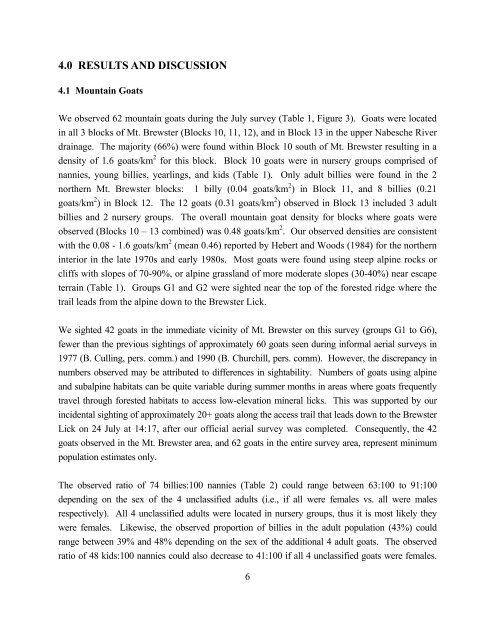Summer inventory of mountain goats and Stone's sheep ... - BC Hydro
Summer inventory of mountain goats and Stone's sheep ... - BC Hydro
Summer inventory of mountain goats and Stone's sheep ... - BC Hydro
Create successful ePaper yourself
Turn your PDF publications into a flip-book with our unique Google optimized e-Paper software.
4.0 RESULTS AND DISCUSSION<br />
4.1 Mountain Goats<br />
We observed 62 <strong>mountain</strong> <strong>goats</strong> during the July survey (Table 1, Figure 3). Goats were located<br />
in all 3 blocks <strong>of</strong> Mt. Brewster (Blocks 10, 11, 12), <strong>and</strong> in Block 13 in the upper Nabesche River<br />
drainage. The majority (66%) were found within Block 10 south <strong>of</strong> Mt. Brewster resulting in a<br />
density <strong>of</strong> 1.6 <strong>goats</strong>/km 2 for this block. Block 10 <strong>goats</strong> were in nursery groups comprised <strong>of</strong><br />
nannies, young billies, yearlings, <strong>and</strong> kids (Table 1). Only adult billies were found in the 2<br />
northern Mt. Brewster blocks: 1 billy (0.04 <strong>goats</strong>/km 2 ) in Block 11, <strong>and</strong> 8 billies (0.21<br />
<strong>goats</strong>/km 2 ) in Block 12. The 12 <strong>goats</strong> (0.31 <strong>goats</strong>/km 2 ) observed in Block 13 included 3 adult<br />
billies <strong>and</strong> 2 nursery groups. The overall <strong>mountain</strong> goat density for blocks where <strong>goats</strong> were<br />
observed (Blocks 10 – 13 combined) was 0.48 <strong>goats</strong>/km 2 . Our observed densities are consistent<br />
with the 0.08 - 1.6 <strong>goats</strong>/km 2 (mean 0.46) reported by Hebert <strong>and</strong> Woods (1984) for the northern<br />
interior in the late 1970s <strong>and</strong> early 1980s. Most <strong>goats</strong> were found using steep alpine rocks or<br />
cliffs with slopes <strong>of</strong> 70-90%, or alpine grassl<strong>and</strong> <strong>of</strong> more moderate slopes (30-40%) near escape<br />
terrain (Table 1). Groups G1 <strong>and</strong> G2 were sighted near the top <strong>of</strong> the forested ridge where the<br />
trail leads from the alpine down to the Brewster Lick.<br />
We sighted 42 <strong>goats</strong> in the immediate vicinity <strong>of</strong> Mt. Brewster on this survey (groups G1 to G6),<br />
fewer than the previous sightings <strong>of</strong> approximately 60 <strong>goats</strong> seen during informal aerial surveys in<br />
1977 (B. Culling, pers. comm.) <strong>and</strong> 1990 (B. Churchill, pers. comm). However, the discrepancy in<br />
numbers observed may be attributed to differences in sightability. Numbers <strong>of</strong> <strong>goats</strong> using alpine<br />
<strong>and</strong> subalpine habitats can be quite variable during summer months in areas where <strong>goats</strong> frequently<br />
travel through forested habitats to access low-elevation mineral licks. This was supported by our<br />
incidental sighting <strong>of</strong> approximately 20+ <strong>goats</strong> along the access trail that leads down to the Brewster<br />
Lick on 24 July at 14:17, after our <strong>of</strong>ficial aerial survey was completed. Consequently, the 42<br />
<strong>goats</strong> observed in the Mt. Brewster area, <strong>and</strong> 62 <strong>goats</strong> in the entire survey area, represent minimum<br />
population estimates only.<br />
The observed ratio <strong>of</strong> 74 billies:100 nannies (Table 2) could range between 63:100 to 91:100<br />
depending on the sex <strong>of</strong> the 4 unclassified adults (i.e., if all were females vs. all were males<br />
respectively). All 4 unclassified adults were located in nursery groups, thus it is most likely they<br />
were females. Likewise, the observed proportion <strong>of</strong> billies in the adult population (43%) could<br />
range between 39% <strong>and</strong> 48% depending on the sex <strong>of</strong> the additional 4 adult <strong>goats</strong>. The observed<br />
ratio <strong>of</strong> 48 kids:100 nannies could also decrease to 41:100 if all 4 unclassified <strong>goats</strong> were females.<br />
6
















